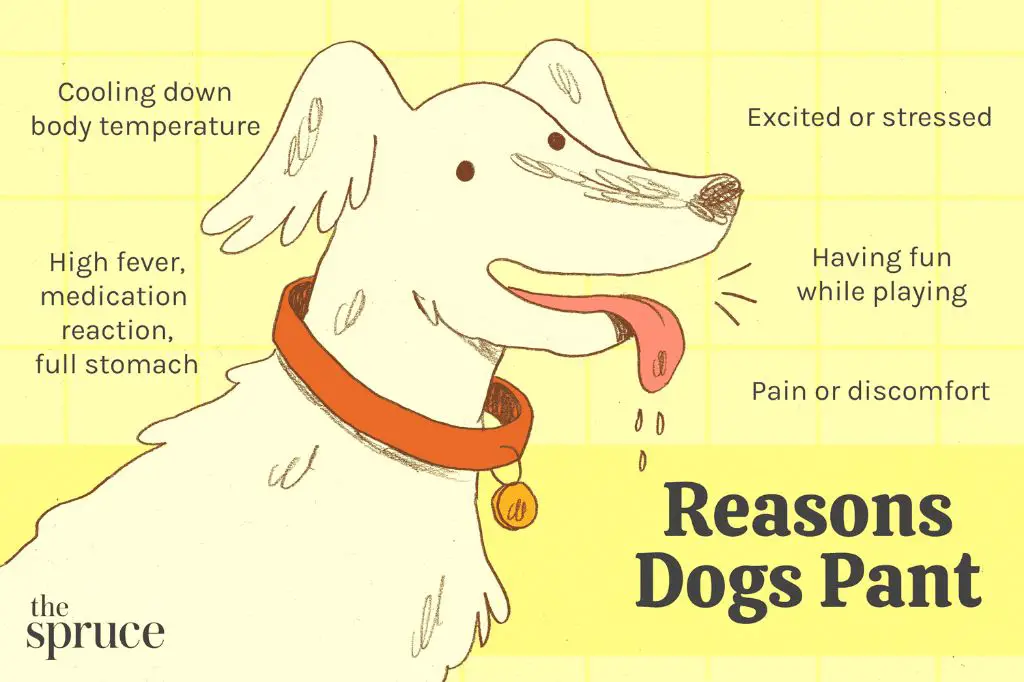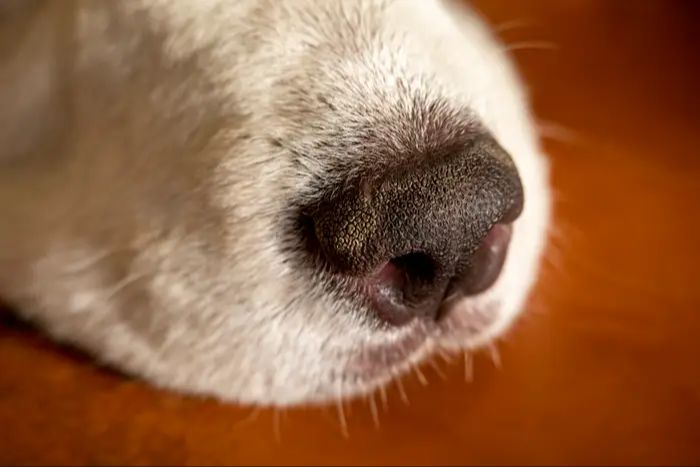Introduction
A dog’s nose is one of their most powerful sensory organs. A dog relies on their sense of smell to interpret their environment and interact with the world around them. A cold, wet nose is perfectly normal and even healthy for a dog. But should you be concerned if your dog’s nose feels warm and dry? Understanding the typical temperature range for a dog’s nose and what may cause fluctuations can help owners discern normal variations from more serious conditions requiring veterinary attention.
In this article, we will look at the anatomy behind your dog’s incredible sense of smell, examine what constitutes a normal nose temperature, and identify possible reasons for temperature changes. We’ll also provide tips for keeping your dog’s nose cold and debunk common myths. With the right information, dog owners can better monitor the health of their pet’s nose.
Anatomy of a Dog’s Nose
A dog’s nose contains a complex network of blood vessels that help regulate body temperature. The wetness and coolness of a dog’s nose is largely due to the mucus membranes and blood supply inside their nostrils.
The mucus membranes inside a dog’s nose work to trap scent particles. This allows dogs to have such an excellent sense of smell. These membranes contain many blood vessels near the surface, which provide the rich blood supply a dog’s nose needs to stay cold and wet.

Dogs also have an organ called the nasal turbinates, which are scroll-like bony structures covered by these mucus membranes. The large surface area of the nasal turbinates allows dogs to warm and humidify the air they breathe before it reaches their lungs.
This complex nasal anatomy allows a healthy dog to have a nose that is moist and cool to aid their exceptional sense of smell. The blood vessels keep the nose cold while the mucus keeps it wet.
Normal Temperature Range
The normal temperature range for a healthy dog’s nose is quite broad. According to veterinarians, a dog’s nose can range from cool/moist to warm/dry when they are perfectly healthy. However, the most common healthy temperature is cool and moist.
More specifically, a dog’s nose temperature tends to mirror the environment. In cooler weather or temperatures, a dog’s nose will be cooler. In warmer environments, a dog’s nose may be warmer. The nose temperature can fluctuate throughout the day as the temperature changes.
As long as the nose is within this broad range and matches the environment, there is usually no cause for concern. Dramatic shifts in nose temperature or a nose temperature that doesn’t align with the weather may be a sign of illness.
Why a Cold, Wet Nose is Normal
A cold, wet nose is normal and healthy for dogs due to the unique anatomy and physiology of their nasal passageways. Dogs have a special network of blood vessels called venous sinuses in their nose which function to cool and humidify inhaled air before it reaches the lungs. When blood flows through these sinuses, it loses heat to the incoming air, thereby cooling the nasal passageways and the surface of the nose. This is an essential temperature regulation mechanism that prevents overheating during panting.

Dogs also have mucus glands lining the nasal cavity which keep the nose wet and lubricated. The moisture helps trap scent molecules, allowing dogs to smell much better than humans. The wetness combined with the cool venous blood flow is why healthy dogs typically have a cold, moist nose.
Veterinarians consider a cold, wet nose as a sign of good circulation and normal thermoregulation in dogs. A warm, dry nose may indicate illness, fever, or dehydration as it suggests reduced blood flow to the nasal passages or decreased mucus production.
So in summary, a cold, wet nose on a dog is very normal and a good indicator of health, due to the special anatomy and blood flow characteristics of the canine nasal cavity.
Exceptions to a Cold Nose
While a cold, wet nose is normal for most dogs, there are some situations when a dog’s nose may feel warm or dry temporarily. This does not necessarily indicate a health problem.
After exercise or activity, increased blood flow can make a dog’s nose warmer. The airflow over the wet surfaces of the nose during exercise causes evaporation that cools the tissues. When the dog stops exercising, it takes a little while for the nose to cool down again.
Dogs pant to cool down, so a hot, stuffy environment can make the nose warmer. Dogs have a small amount of saliva on the nose normally that evaporates to cool the skin. In very hot and humid weather, that cooling system does not work as well.
Sleeping curled up or burrowing into bedding may also warm a dog’s nose for a while. Body heat under the covers can raise the nose’s temperature temporarily.
Keep in mind that dogs shake themselves when they wake up from a nap or rest period. This helps re-wet the nose.
While a consistently warm, dry nose could indicate illness, these temporary warm periods are nothing to worry about. Look for other clinical signs or prolonged change in nose temperature if concerned.
When to Worry
A dog’s nose changing from cold and wet to warm and dry can sometimes be an indicator of illness or injury. Here are some reasons to seek veterinary attention if you notice your dog’s nose is not cold:

-
Fever – If your dog has a high temperature or fever, circulation increases to help cool the body down. This can lead to a warm, dry nose.
-
Dehydration – Lack of fluids and electrolyte imbalances can cause poor circulation and a dry nose.
-
Shock – Any condition that causes a dangerous drop in blood pressure, like trauma, blood loss, poisoning, sepsis or heart conditions can make the nose dry.
-
Nasal Injury or Disease – Injuries, abscesses, tumors or nasal mites found inside the nasal cavity can lead to a warm or intermittent dry nose.
-
Nerve Damage – Diseases affecting the facial nerves, like trigeminal neuritis, can disrupt normal nasal functions.
-
Anemia – Low red blood cell levels reduce oxygen circulation.
-
Malnutrition – Lack of vitamins and nutrients affects body systems.
It’s important to have your vet examine your dog if you notice a persistently warm and dry nose along with other symptoms like lethargy, appetite changes or breathing issues. Some causes like fever require prompt treatment.
Tips for Keeping Nose Cold
A dog’s cold, wet nose is normal and healthy. Here are some tips pet owners can follow to help keep their dog’s nose in optimal condition:

-
Provide plenty of fresh, clean water – Dehydration can cause nose dryness so always ensure your dog has access to water.
-
Walk in cooler weather – Avoid strenuous exercise when it’s hot out to prevent overheating and nose dryness.
-
Keep your dog well-groomed – Trim hair around nose so it doesn’t trap moisture and cause the nose to dry out.
-
Use a humidifier – Running a humidifier can add moisture to the air and prevent your home from getting too dry.
-
Apply snout soother – Pet-safe snout soothers can provide moisture and protect delicate nasal tissue.
-
Try a wet food diet – The extra moisture from wet dog food can help hydrate your dog from the inside out.
Following these simple tips can help ensure your pup maintains their signature cold, wet nose – a sign they are healthy and happy.
Myths
There are a few common myths and misconceptions when it comes to dogs’ noses and temperatures that are important to debunk.
One myth is that if a dog’s nose is warm or dry, they must be sick. While this can be a sign of illness, there are many other explanations. Dogs’ noses naturally fluctuate between wet and dry throughout the day. The weather, drinking water, exercise, and resting can all impact the moistness of a dog’s nose.
Another myth is that you can accurately take a dog’s temperature by feeling their nose. A dog’s body temperature ranges between 100-102.5 degrees Fahrenheit, while their nose is often cooler, around 80 degrees. Feeling the nose does not give an accurate reading of the dog’s core body temperature.
It’s also a myth that a cold, wet nose means a dog is healthy. While this is typically true, some sick dogs may still have a cold, wet nose. Changes in nose temperature and moisture provide clues about a dog’s health, but do not give the full picture.
The myth that dogs only get “cold noses” in winter cold weather is also untrue. Dogs can have cold noses year round, despite the outdoor temperature. Their bodies regulate temperature independently from the environment.
Other Signs of Illness
In addition to nose temperature, there are other signs that may indicate illness in dogs:
-
Lethargy and lack of energy
-
Loss of appetite or decreased appetite
-
Weight loss
-
Vomiting
-
Diarrhea
-
Increased thirst and urination
-
Labored or rapid breathing
-
Pale gums
-
Yellowing of eyes or gums
-
Unusual hair loss or scaly skin
-
Frequent head shaking or scratching
-
Lameness or limping
-
Whining, crying or other signs of pain
-
Coughing or sneezing
-
Unusual discharges from nose, eyes or other body openings
-
Bleeding or swelling
-
Difficulty breathing
-
Seizures or tremors
-
Confusion, disorientation or other behavioral changes
If your dog exhibits any of these symptoms in an unusual way, it’s a good idea to consult your veterinarian. While many of these signs can occur normally or point to minor issues, they may also indicate underlying illness that requires medical attention.
Summary
A dog’s nose is one of its most powerful sense organs, and it certainly is an interesting anatomical part of man’s best friend. As we’ve outlined, it’s completely normal and not a cause for concern that your dog has a cold, wet nose. This is because of the unique capillary structure under their nose that promotes heat exchange to keep it cool and moist.
There are some exceptions, such as during sleep or sickness, where a dog’s nose may feel warmer or drier. But in general, the best indicator of your dog’s health is their energy level, appetite, and behavior – not nose temperature.
Keeping your dog’s nose cold and wet contributes to their ability to smell. Simple tips like providing water, using nose balms, and keeping them from overheating are easy ways owners can support nasal health. It’s also important not to buy into false myths about nose temperature being connected to breed or gender.
Understanding why your dog’s nose is cold and wet is useful knowledge for any pet owner. By learning the science behind it, you can monitor your dog’s health more accurately and discern when their nasal temperature does require a closer look.